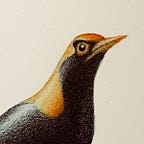A Guide to Peterson’s Fourth
for the thrifty collector
Roger Tory Peterson’s seminal book A Field Guide to the Birds was by the mid-1970s well established as THE field guide to North American birds. In spite of this, competing guides from Golden and Audubon had challenged Peterson for the market with more up-to-date material, maps and improvements in layout and design.
Responding to their challenge, Peterson completely revised and updated his flagship book, releasing the fourth edition of A Field Guide to the Birds in 1980 to near-universal acclaim.
Peterson died in 1996, making the fourth edition the last and most complete version of the guide published within his own lifetime. It remained in print for 22 years before being replaced by the posthumous fifth edition in 2002.
Owing to its long production run, a number of variations in title, format and cover design appeared over the years, as well as limited and special editions that present the collector with many options and challenges.
In the spirit of Peterson’s original vision, the following points are provided as a basic and practical guide for identifying most of the versions in circulation.
Titles
Perhaps the single most confusing aspect of the fourth edition is it’s title, which appears differently on the spine, title page, half-title, cover – and evolved as new and special versions were released to market.
Officially, the book’s full title is ‘A Field Guide to the Birds of Eastern and Central North America’, but the title appearing on the earliest covers was ‘A Field Guide to the Birds East of the Rockies’, which was later updated to ‘Eastern Birds’.
Worth noting are the unique titles given to the special 12th-printing ‘Peterson’s Field Guide To The Birds’ and the Easton Press special edition ‘Birds Of The Eastern United States’, which presumably was not made available to the Canadian market.
Formats
Adding to the confusion, the fourth edition was also offered in three distinct formats: hardcover, softcover and flexibook; a water-resistant binding that is more flexible than hardcover and more durable than softcover.
Book collectors generally focus on hardcovers, ignoring softcovers and flexibooks altogether. Perhaps because of this, softcovers and flexibooks outnumber hardcovers in the market, are priced lower, and offer a good buying opportunity for the thrifty collector.
Covers
In addition to the three formats offered, a number of design changes were introduced as the book’s marketing was evolved. By appearance, they can be grouped broadly into four distinct styles:
However, subtle variations within each style, such as changes to text, faux-stickers etc. do warrant closer attention.
Special Editions
Coinciding with the fourth edition’s debut in 1980, Houghton Mifflin also produced a collectors edition, limited to 1000 copies, and bound in green moroccan leather with gilt accents and edges.
Each copy was signed and numbered by Peterson in red ink on the limitation page, and includes the date ‘1980’ on the title page, signifying it as a true first printing as per HMCo. tradition.
My favourite of all is the little-known 12th printing, specially-bound by the National Publishing Company in teal-green leather with matching slipcase, speckled edges, and signed in red ink on the title page.
It’s not a numbered edition, but is presumably limited to a single printing and appears to be quite rare given how few records of it exist online.
Not pictured here, but still worth mentioning is the Easton Press 50th Anniversary Edition of 1984, titled Birds Of The Eastern United States, bound in blue leather with gilt edges.
It’s not entirely clear whether Peterson’s signature in these books was hand-signed or reproduced by machine, but in either case, many of these books were sold and they are neither numbered nor particularly rare.
Printings
First printings of the fourth edition can be determined by the presence of the date ‘1980’ at the bottom of the title page, or by a number-series ending in ‘1’ on the copyright page.
Later printings have no date on the title page, but can still be determined by the lowest number shown in series on the copyright page.
For example, ‘H 19 18 17 16 15 14 13 12’ indicates it is a twelfth printing of the fourth edition. It does not indicate a total of 19 printings however, as the largest number in sequence was subject to grow with additional printings.
Precise dates of printings are never given, but the year can be estimated by the most recent volume advertised opposite the title page. In the example above, ‘Warblers by Dunn & Garrett’ was first published in 1997, therefore the book pictured must have been printed later.
References
The points given above are not intended to be exhaustive and merely reflect my own collecting and understanding up until this moment.
If you are seeking a more comprehensive bibliography of all editions and their variations — including foreign translations, uncorrected proofs and other rarities — a printed guidebook by Scott F. Bastian is available for purchase and provides more answers than I myself had questions for.
For a brief, but excellent overview of Peterson’s other works and their collectibility, I also recommend A book collector’s guide to Roger Tory Peterson by Paul A. Johnsgard.
